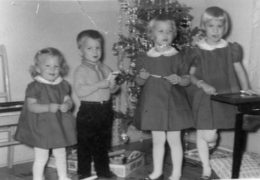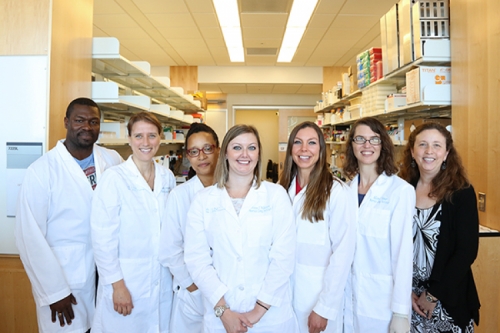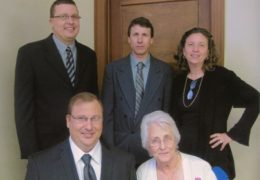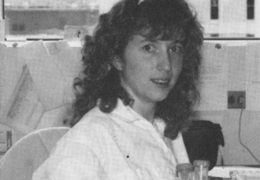Wanda (Lemna) O’Neal was four years old when her sister Nancy died.
“I remember my father got a call from the hospital,” O’Neal says. “It was pneumonia, they told me. They said she choked.”
This was 1966. Nancy was only eight, though she’d been sick most of her life. Doctors suspected that Nancy had cystic fibrosis, but they didn’t know what caused the disease. They didn’t know how to treat it.
The family doctor in Enderlin, North Dakota, told Nancy’s mother, “I think you should get all your kids tested for cystic fibrosis. There’s a simple sweat test.”
“I remember that day,” says O’Neal, now an associate professor in the UNC School of Medicine. “It was sad and surreal. We all took our turns going in for the test. My mother kept finding out that another one of her kids had CF. I know that she knew before they told her, because we all knew which kids were thin and which ones coughed a lot. But she still cried.”

Courtesy of Wanda O’Neal
The Lemna kids, Christmas 1964. From left: Wanda, Ron, Nancy, and Joanne. All but Wanda died from cystic fibrosis when they were children.
Of the eight Lemna children born at the time, six were diagnosed with the disease. As a result, the Lemna home was a place full of young kids who coughed through the nights. They suffered through lung infections and other health problems. Only Wanda and younger brothers Bill and Jeff didn’t have it.
“My childhood was demarcated by someone dying,” O’Neal says. “For 16 years, my mother took care of sick kids, and despite all her efforts, we watched as each of them died from the same disease in basically the same way.”
Except one: Mike.
“He was never really sick, but he definitely had CF,” O’Neal says. “When my brother Danny died, he was a year younger than Mike but always much sicker. My mom was constantly taking care of Danny and the others, and there was Mike, just hanging out.”
Today, Mike is approaching 50, and he’s rarely been hospitalized. “Something is protecting my brother,” says O’Neal. “We don’t know what. But what if it’s something simple? What if it’s the same thing that protects other CF patients who have milder disease? What if we could find out what it is and exploit that knowledge?”

Photo by Max Englund, UNC Health Care The O’Neal lab. From left: Rodney Gilmore, Alessandra Livraghi-Butrico, Kristy Terrell, Kristin Wilkinson, Lisa Jones, Allison Volmer, and Wanda O’Neal.
These questions are at the center of O’Neal’s latest research. She’s part of a UNC team renowned for its basic science and clinical approaches to developing better treatments, while searching for a cure to CF.
This year, O’Neal and her colleagues at the Marsico Lung Institute / UNC CF Research Center homed in on a potential culprit for the development of severe disease: a group of genes that could become therapeutic targets.
O’Neal says this discovery doesn’t mean they’re about to find a magic wand to make CF patients avoid pneumonia. “Science doesn’t seem to work that way,” she says. “People need to understand the generally slow nature of discovery. But we know more than we did, and we know where to keep looking to understand the disease better.”
For O’Neal, being part of a respected team dedicated to improving CF care is a perfect fit and a privilege. But for much of her life—even well into graduate school—she thought the disease that took her five siblings was part of her past, not her future.
Life on the Farm
When she was young, O’Neal never thought she’d become a scientist. Instead, she found solace in life on the family farm.
“It was rare for a girl to be so interested in farming back then, and probably even rarer for a father to let his daughter farm,” O’Neal says. “But I was a tomboy. I loved farming, and my dad was really supportive.”
She milked cows and took turns on the tractor. When she turned 16, O’Neal’s dad got rid of the cows and became a grain farmer. Wheat, corn, sunflowers. Sixteen-hour workdays were commonplace, and O’Neal’s work ethic translated into the classroom, where she excelled in all subjects.
Straight A’s throughout high school made college a logical choice, and O’Neal became the first person in her family to attend. She chose North Dakota State, an hour away in Fargo. Her favorite subject was biology. She loved learning about plant diseases. It was during her crop science classes when O’Neal was first introduced to the field of genetics.
“I just loved the subject,” she recalls. “Fundamentally, plant genetics is not much different than human genetics.”
She often thought of her siblings and the nebulous idea that she shared similar genetics to them, even though she and two of her brothers were somehow spared getting cystic fibrosis. The last of her siblings with severe CF, Danny, died when O’Neal was a junior.
In 1984, with a bachelor’s of science under her belt, O’Neal pursued a master’s in crop science. Her parents were puzzled; why the need for a master’s? “My family didn’t understand me, and I was struggling to figure out what I wanted to do. To them, I was, ‘all brains and no common sense.’”
After two years, and still enamored with academia, she was accepted into NDSU’s crop-science PhD program. She loved pathology, the science behind how crops got disease or stayed healthy. But prior to starting the doctorate program, she confided to a friend that she didn’t know what she’d do with another degree.
That friend then asked a simple question: “Well, Wanda, forget about crop science for a minute. What do you really want to do with your life?”
Without thinking, O’Neal blurted out, “What I really want to do is work on CF.”
Back then—because of where she had come from, her family, her farm—the notion of becoming a biomedical researcher had never crossed her mind.
“I had no idea how to even go about it,” O’Neal says. “But it made total sense—the genetics of it, my family, my love of biology. Once I thought of it, there was no turning back.”
Life at the Bench
Soon after, O’Neal went to the library to find a program with faculty who worked on cystic fibrosis. She chose Baylor College of Medicine, and joined the lab of Arthur Beaudet, a professor of molecular and human genetics.
While applying and interviewing, O’Neal didn’t mention her siblings. She didn’t mention how Mike was still alive and doing well, while her other siblings had died long before they were old enough to vote.
“But when I joined Dr. Beaudet’s lab, I did tell him, and I asked if I could work on CF,” O’Neal says. “At first, he was a little hesitant, I think because he had had some experience with people who wanted to do research for personal reasons.
“I think, sometimes, people who take their work really personally think they have to cure something or solve the entire problem quickly,” O’Neal says. But science, for the most part, is a series of small steps. “People can become so emotionally involved that they can’t make progress. Or the emotion becomes a distraction, and that makes it harder for them to function.”
But O’Neal could focus. At Baylor, she continued her success in the classroom. And Beaudet noticed O’Neal’s workman-like attitude. In the lab, she took well to the drudgery of repetitive experiments. She didn’t mind; they were like those long days plowing the farm.
“I think I was able to do tasks that maybe other people… well, they didn’t really want to do them. I didn’t feel like I was out of place doing anything. Dr. Beaudet accepted me.”
Not long after she joined the lab in the fall of 1988, scientists discovered the gene responsible for CF. They called it CFTR. Scientists realized that people could carry one faulty copy of the gene—as O’Neal’s parents did—and if each child acquired one faulty copy from each parent, then the result was cystic fibrosis.
“My parents were unlucky,” O’Neal says. “Odds were that only two or three kids would get both copies and get CF. Instead, six did.”
But still there was Mike. Two copies of the CFTR gene, but he didn’t die. He never even got pneumonia. And as researchers would learn soon after the discovery of the CF gene, there were other people with CF who inherited both copies of the faulty CFTR gene without experiencing severe disease.
Researchers began parsing the intricacies of CF biology as they searched for a cure. Eventually, they found that the CFTR gene could mutate in different ways.
Beaudet, noticing O’Neal’s work ethic, put her in charge of genotyping all the DNA his lab had acquired from CF patients in search of those that carried the Delta F508 mutation, which turned out to be the most common CFTR mutation—the underlying reason O’Neal’s brothers and sisters had died.
In those days, with the gene in hand, researchers thought a cure was within reach. Then, when scientists introduced the concept of gene therapy as the newest big idea in biomedical science, cystic fibrosis researchers thought they had a clear route to a cure.
The Complicated Truth
The idea of gene therapy is simple. If there’s a disease in which only one gene is faulty—like CF, sickle cell disease, Huntington’s disease—then we ought to be able to replace that gene with a working copy. But single-gene diseases turned out to be more complex to treat with gene therapy than people originally hoped, especially for CF.
To transmit working copies of the CFTR gene to the lungs, scientists needed a vehicle—something to carry the genes to the place they needed to go. The best candidate in the 1990s and 2000s was a rejiggered virus. The idea was to scrape out the viral genes that made the virus harmful and add the CFTR genes. Then scientists would introduce the CFTR viral vector into the lungs, and the new genes would properly express the CFTR proteins, which would play their part in maintaining pulmonary health.
It didn’t work, and there were probably several reasons.
“With gene therapy, researchers were trying to target cells in the airway: epithelial cells, which are designed to prevent things from getting into them,” O’Neal says. “The whole purpose of these cells is to clear junk from the lungs, to provide a barrier so nothing gets through them.”
Inside our lungs is a layer of mucus that traps all kinds of particles we breathe in every minute of every day. This mucus slides on a watery layer, beneath which lie the epithelial cells that move the mucus, and all those particles, out of the lungs.
We rarely think about this natural process. But CF patients think about it all the time, because the faulty CFTR gene makes mucus thicker and more difficult to remove. In CF patients, the mucus still traps particles. But some of the particles, such as Pseudomonas, fester and cause infection.
Getting a viral particle to infiltrate this protective system has thus far proved too difficult.
“The mucosal layer is just very protective,” O’Neal says. “And if something would get through, then the cells would sense it and do everything they could to get rid of it.” It didn’t matter if that “something” were a harmless virus carrying potentially lifesaving cargo.
As gene therapy wasn’t panning out, CF researchers continued to develop better ways to treat patients, including physical therapies, antibiotics, and improved methods for keeping the airways clear.
Also, researchers began learning more about different CFTR mutations. They’ve now identified about 1,800 different mutations to the same gene, including the most common one: the Delta F508 mutation.
It’s easy to understand why people with different mutations experience different levels of disease severity. But why did every member of O’Neal’s family suffer from severe CF, except Mike?
Researchers suspected that the clues were in the DNA of the cells at the center of the disease.
Carolina Connection
At Baylor, O’Neal genotyped all of the DNA samples Beaudet’s team collected from CF patients to identify those with the Delta F508 mutation. She found that about 80 percent of CF patients had the Delta F508 mutation. She also found that this mutation happened much less frequently in people with Jewish ancestry.
O’Neal stayed on for a postdoctoral fellowship at Baylor, where her husband was finishing his residency. Toward the end of their time in Texas, her mentor phoned a colleague in Chapel Hill to put in a good word. That colleague was Richard Boucher, whose UNC research team had created the first mouse model of CF. That research was published just as O’Neal’s mouse models of CF were being born at Baylor. Impressed, Boucher invited O’Neal to join UNC’s burgeoning CF Center as a research associate.
As a molecular geneticist, O’Neal started to work with a variety of faculty—biochemists, cell biologists, mucus experts, microbiologists, geneticists. She settled into life at UNC in the late 1990s, and became director of the UNC CF Center Molecular Biology Core in 2002.
A coauthor on more than 50 scientific papers, O’Neal has been part of a UNC research operation that has become a leader in defining the biology and genetics of the CF lung, testing potential therapies, searching for cures, and creating new treatments, such as hypertonic saline.
One of her main collaborators became Michael Knowles, a professor of pulmonary and critical-care medicine, who for a decade has spearheaded an effort to gather thousands of genetic and blood cell samples from CF patients across the country. One of his goals has been to identify genes and cellular proteins that have subtle effects inside cells but produce dramatic differences in disease severity.
Decades of research on the functions of proteins have allowed scientists to group genes into pathways based on their common biological roles. Scientists deduced that some of these pathways should interact with the main protein created by the CFTR gene.
This is how CF biology works:
In a normal epithelial cell, the CFTR gene creates a protein that moves from the cell nucleus to the cell membrane, where it works to maintain proper lung function. As the protein moves from nucleus to membrane, it interacts with many genes, creating a genetic pathway, so that the protein can complete the journey and work properly in the end.
In CF patients with the Delta F508 mutation, the CFTR gene does not fold into its correct form and cannot make it to the cell surface. It turns out that the Delta F508 protein doesn’t simply make its journey on its own. Nor does it manage to work properly on its own. Other genes are involved. Other pathways.
Paths toward treatments

Courtesy of Wanda O’Neal. The surviving Lemnas in 2013. From top left: Jeff, Mike, Wanda, Bill, and their mother Mary.
For their most recent study of these genes, Knowles, O’Neal, and a group of other researchers used gene-expression data from cells collected from 750 patients gathered over the past decade. Along with NC State biostatistician Fred Wright and others, Knowles and O’Neal analyzed more than 4,000 genetic pathways to find the ones that played roles in CF.
They identified significant genetic variation in two broad types of pathways: endomembrane pathways and HLA pathways.
According to Knowles and O’Neal, disease severity partially depends on how genes in these pathways function. They discovered that when these pathways or groups of genes produce a larger amount of proteins, CF patients had less severe symptoms. When genes in these pathways were expressed in lower amounts, patients experienced a more severe form of the disease and were more likely to be hospitalized.
“Now that we’ve found these pathways, we need to dig into the biology to see how specific genes within the pathways influence disease severity,” O’Neal says. “We hope we can target these genes to limit the severity of disease. If so, this could help all patients in a big way.”
The work could also provide important clues for why new CF treatments work well for some patients but not for others.
In 2012, a drug called Kalydeco came on the market. It was considered a miracle drug for CF patients who had specific kinds of mutations responsible for about 4 or 5 percent of all CF cases. The drug does not work for the majority of patients—those with the Delta F508 mutation. It’s also extremely expensive.
Last year, a combination therapy of two drugs showed that it could improve lung function in patients with Delta F508 mutations, but in clinical trials the effect was modest for most patients. Some patients didn’t experience any benefit.
“Why is that?” Knowles says. “Well, it could be that these genetic pathways play roles not only in severity of disease but whether a person responds to specific therapies, including these new drugs. We really want to know if people who respond well have higher expression of these genetic pathways we’ve identified. If so, then we’re on the heels of personalized approaches to treating CF patients at the level of their genes.”
Pieces of the Puzzle
When Kalydeco came out, O’Neal called her brother Mike to tell him. He still had never been hospitalized for pneumonia but he had been for intestinal obstruction, a common problem for adults with cystic fibrosis. She told him, “Look, if you have a certain kind of genetic mutation, you might want to consider this new drug. We need to test you.”
Mike agreed. He didn’t have one of the rare mutations that Kalydeco addresses. He had the classic Delta F508 mutation.
“I don’t know if we’ll ever know why Mike, per se, has been protected against severe disease,” O’Neal says. “But now we have identified a few groups of genes that the research community can explore to figure out what might trigger severe disease—or protect against it. And it could be possible to manipulate these genes so that all CF patients could benefit.”
When the O’Neal’s siblings were diagnosed in the 1960s, most patients didn’t live past their elementary school years. Now, half of all CF patients in the United States are older than 18, but much more work needs to be done.
When O’Neal began working on CF in the 1980s and especially when the CFTR gene was discovered in 1989 and scientists thought gene therapy could be the answer, she and others hoped that they could be curing patients by the end of the twentieth century. It turned out that a simple single-gene disease was more complicated.
Finding better treatments and cures took large groups of scientists, dedicated patients and parents, drug companies, and substantial investment from funding agencies—especially the NIH and the Cystic Fibrosis Foundation—and individuals such as Thomas Marsico. Kalydeco, for instance, happened after decades of basic research that cost millions of dollars. The clinical trial got the press that it deserved, but it would’ve been impossible to achieve clinical success without basic lab research.
In basic science, O’Neal found her calling.
“I’m very happy to be a piece of the puzzle. As director of the molecular core here at the CF Center, I’m in a position that allows me to help many people in the research community,” O’Neal says. “Really, with almost anything related to molecular genetics, our core can help. This is a great fit for me.”
If scientists need to know the level of expression of the CFTR gene in specific cells, O’Neal can find out. If they need RNA or DNA analyzed, they go to the molecular core. If they need to test a drug, or find out how it interacts with specific proteins, they talk to O’Neal.
And as someone who lost five siblings to the same disease, O’Neal knows what’s at stake for patients and their families.
“It’s important for families to know that there are people working on this disease and that we care about it,” she says. “It’s important to be able to say to your child that there might be a cure—not today or tomorrow—but that good people are working on it and that there is hope. I honestly don’t think this is false hope. I think it’s real, because we’ve come far since I was a kid. I don’t ever want to lose sight of that.”



